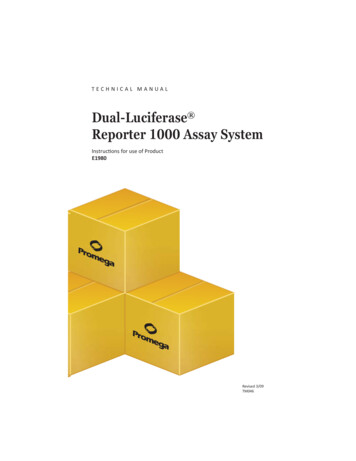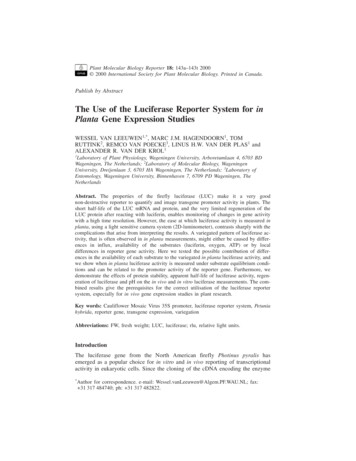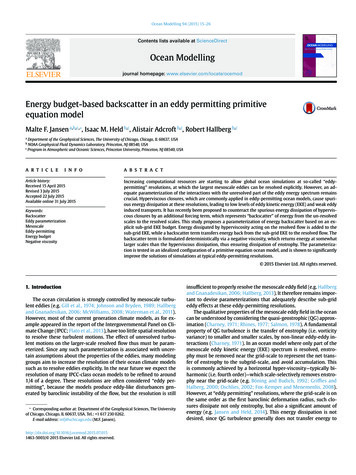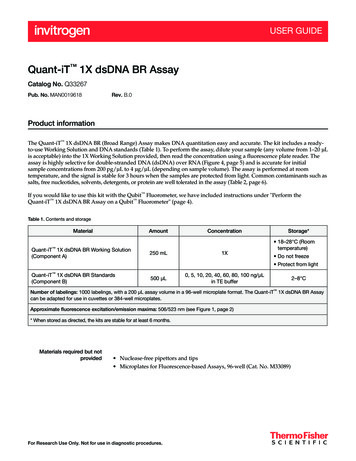
Transcription
TECHNICAL MANUALDual-Luciferase Reporter 1000 Assay SystemInstrucƟons for use of ProductE1980Revised 3/09TM046
tm046.0309:EIVD TM.qxd3/21/20114:08 PMPage 1Dual-Luciferase Reporter 1000 Assay SystemAll technical literature is available on the Internet at: www.promega.com/tbs/Please visit the web site to verify that you are using the most current version of thisTechnical Manual. Please contact Promega Technical Services if you have questions on useof this system. E-mail: techserv@promega.com.1. Description.2A. Dual-Luciferase Reporter Assay Chemistry.3B. Format of the Dual-Luciferase Reporter 1000 Assay in 96-Well Plates .6C. Passive Lysis Buffer .72. Product Components and Storage Conditions .83. The pGL4 Luciferase Reporter Vectors .8A. Description of pGL4 Vectors .8B. Important Considerations for Co-Transfection Experiments .94. Instrument Considerations .9A. Plate-Reading Luminometers .9B. Single-Sample Luminometers.105. Preparation of Cell Lysates Using Passive Lysis Buffer.11A. Passive Lysis Buffer Preparation .11B. Passive Lysis of Cells Cultured in Multiwell Plates .116. Dual-Luciferase Reporter 1000 Assay Protocol.13A.B.C.D.E.F.Preparation of Luciferase Assay Reagent II .13Preparation of Stop & Glo Reagent .13Assay Protocol for 96-Well Plates.14Protocol for Use with Manual or Single-Injector Luminometers.15Important Considerations for Cleaning Reagent Injectors .16Determination of Assay Backgrounds .177. References .198. Appendix .20A. Composition of Buffers and Solutions .20B. Related Products.20Promega Corporation · 2800 Woods Hollow Road · Madison, WI 53711-5399 USAToll Free in USA 800-356-9526 · Phone 608-274-4330 · Fax 608-277-2516 · www.promega.comPrinted in USA.Revised 3/09Part# TM046Page 1
tm046.0309:EIVD TM.qxd1.3/21/20114:08 PMPage 2DescriptionGenetic reporter systems are widely used to study eukaryotic gene expressionand cellular physiology. Applications include the study of receptor activity,transcription factors, intracellular signaling, mRNA processing and proteinfolding. Dual reporters are commonly used to improve experimental accuracy.The term “dual reporter” refers to the simultaneous expression and measurementof two individual reporter enzymes within a single system. Typically, the“experimental” reporter is correlated with the effect of specific experimentalconditions, while the activity of the co-transfected “control” reporter provides aninternal control that serves as the baseline response. Normalizing the activity ofthe experimental reporter to that of the internal control minimizes experimentalvariability caused by differences in cell viability or transfection efficiency. Othersources of variability, such as differences in pipetting volumes, cell lysis efficiencyand assay efficiency, can be effectively eliminated. Thus, dual-reporter assaysoften allow more reliable interpretation of experimental data by reducingextraneous influences.The Dual-Luciferase Reporter (DLR ) Assay System(a–f) provides an efficientmeans of performing dual-reporter assays. In the DLR Reporter 1000 Assay, theactivities of firefly (Photinus pyralis) and Renilla (Renilla reniformis, also known assea pansy) luciferases are measured sequentially from a single sample. The fireflyluciferase reporter is measured first by adding Luciferase Assay Reagent II (LAR II)to generate a stabilized luminescent signal. After quantifying the fireflyluminescence, this reaction is quenched, and the Renilla luciferase reaction issimultaneously initiated by adding Stop & Glo Reagent to the same tube. TheStop & Glo Reagent also produces a stabilized signal from the Renilla luciferase,which decays slowly over the course of the measurement. In the DLR 1000Assay System, both reporters yield linear assays with subattomole sensitivitiesand no endogenous activity of either reporter in the experimental host cells.Furthermore, the integrated format of the DLR 1000 Assay provides rapidquantitation of both reporters either in transfected cells or in cell-freetranscription/translation reactions.The DLR 1000 Assay System was developed for larger volume users of theDLR Assay and is configured for use in 96-well luminometry plates. Additionalvolume of both assay reagents is supplied to allow priming of reagent injectors.Sufficient lysis reagent (Passive Lysis Buffer, PLB) to allow addition of 20µl/wellin 96-well plates is supplied. For applications requiring more lysis reagent (e.g., 100µl/well), additional PLB may be purchased separately (Cat.# E1941). Thecomponents of the DLR 1000 Assay System are identical in formulation to thoseprovided with the DLR Assay System (Cat.# E1910 and E1960).Promega offers the pGL4 series of firefly and Renilla luciferase vectors designedfor use with the DLR Assay Systems. These vectors may be used toco-transfect mammalian cells with experimental and control reporter genes.Promega Corporation · 2800 Woods Hollow Road · Madison, WI 53711-5399 USAToll Free in USA 800-356-9526 · Phone 608-274-4330 · Fax 608-277-2516 · www.promega.comPart# TM046Page 2Printed in USA.Revised 3/09
tm046.0309:EIVD TM.qxd3/21/20114:08 PMPage 31.A. Dual-Luciferase Reporter Assay ChemistryFirefly and Renilla luciferases, because of their distinct evolutionary origins, havedissimilar enzyme structures and substrate requirements. These differencesmake it possible to selectively discriminate between their respective bioluminescent reactions. Thus, using the DLR Assay Systems, the luminescencefrom the firefly luciferase reaction may be quenched while simultaneouslyactivating the luminescent reaction of Renilla luciferase.Firefly luciferase is a 61kDa monomeric protein that does not require posttranslational processing for enzymatic activity (1,2). Thus, it functions as agenetic reporter immediately upon translation. Photon emission is achievedthrough oxidation of beetle luciferin in a reaction that requires ATP, Mg2 andO2 (Figure 1). Under conventional reaction conditions, the oxidation occursthrough a luciferyl-AMP intermediate that turns over very slowly. As a result,this assay chemistry generates a “flash” of light that rapidly decays after thesubstrate and enzyme are mixed.Many of our Luciferase Assay Reagents for quantitating firefly luciferaseincorporate coenzyme A (CoA) to provide more favorable overall reactionkinetics (3). In the presence of CoA, the luciferase assay yields stabilizedluminescence signals with significantly greater intensities (Figure 2) than thoseobtained from the conventional assay chemistry. The firefly luciferase assay isextremely sensitive and extends over a linear range covering at least sevenorders of magnitude in enzyme concentration (Figure 3).Renilla luciferase, a 36kDa monomeric protein, is composed of 3% carbohydratewhen purified from its natural source, Renilla reniformis (4). However, like fireflyluciferase, post-translational modification is not required for its activity, and theenzyme may function as a genetic reporter immediately following translation.The luminescent reaction catalyzed by Renilla luciferase utilizes O2 andcoelenterate-luciferin (coelenterazine; Figure 1).Figure 1. Bioluminescent reactions catalyzed by firefly and Renilla luciferases.Promega Corporation · 2800 Woods Hollow Road · Madison, WI 53711-5399 USAToll Free in USA 800-356-9526 · Phone 608-274-4330 · Fax 608-277-2516 · www.promega.comPrinted in USA.Revised 3/09Part# TM046Page 3
tm046.0309:EIVD TM.qxd3/21/20114:08 PMPage 41.A. Dual-Luciferase Reporter Assay Chemistry (continued)In the DLR Assay chemistry, the kinetics of the Renilla luciferase reactionprovide a stabilized luminescent signal that decays slowly over the course ofthe measurement (Figure 2). Similar to firefly luciferase, the luminescentreaction catalyzed by Renilla luciferase also provides extreme sensitivity and alinear range generally extending over six orders of magnitude (Figure 3). Notethat the effective range of the luminescent reactions may vary depending onthe type of luminometer (e.g., 96-well vs. single-sample) used.An inherent property of coelenterazine is that it emits low-levelautoluminescence in aqueous solutions. Originally this drawback preventedsensitive determinations at the lower end of enzyme concentration. Additionally,some types of nonionic detergents commonly used to prepare cell lysates (e.g.,Triton X-100) greatly intensify coelenterazine autoluminescence. The DLR Assay Systems include proprietary chemistry that reduces autoluminescence to alevel that is not measurable for all but the most sensitive luminometers. PassiveLysis Buffer is formulated to minimize the effect of lysate composition oncoelenterazine autoluminescence. In addition, the DLR Assay Systems includetwo reconstituted assay reagents, Luciferase Assay Reagent II and Stop & Glo Reagent, that combine to suppress coelenterazine autoluminescence. Thus, theDLR 1000 Assay System allows accurate, reproducible quantitation of very lowlevels of Renilla luciferase activities expressed in prepared cell lysates.10090Activity (% peak)807060504030FireflyRenilla20100024681012Time (sec)Figure 2. Luminescent signals generated in the Dual-Luciferase Reporter1000 Assay System by firefly and Renilla luciferases.Promega Corporation · 2800 Woods Hollow Road · Madison, WI 53711-5399 USAToll Free in USA 800-356-9526 · Phone 608-274-4330 · Fax 608-277-2516 · www.promega.comPart# TM046Page 4Printed in USA.Revised 3/09
tm046.0309:EIVD TM.qxd3/21/20114:08 PMFireflyRenilla1,000,000Luminescence (RLU)Page 5100,00010,0001,000100103 4091MA04 3A[Luciferase] (moles/reaction)11 1010–1–14510 11 10–16–17–110 11 10–181Figure 3. Comparison of the linear ranges of firefly and Renilla luciferases. TheDLR 1000 Assay was performed with a mixture of purified firefly and Renillaluciferases prepared in PLB containing 1mg/ml gelatin. A Berthold Orionluminometer was used to measure luminescence. The linear range of each of theluciferase assays using the DLR Assay chemistry exceeds six orders of magnitude,providing detection sensitivity 30 femtograms (approximately 3 10–19 moles) ofluciferase using a single-tube luminometer (see Dual-Luciferase Reporter AssaySystem Technical Manual #TM040). Because plate luminometers are often lesssensitive than single-tube luminometers, the minimum measurable luciferase level isoften higher than for single-tube luminometers. The luminometer used in thisexperiment was configured to accommodate measurement of 384-well plates and soshowed even lower sensitivity. The photomultiplier tube in the Orion is moresensitive to blue light than to green light, thus the Renilla luminescencemeasurements in this figure appear to be brighter than the firefly luminescencemeasurements.Promega Corporation · 2800 Woods Hollow Road · Madison, WI 53711-5399 USAToll Free in USA 800-356-9526 · Phone 608-274-4330 · Fax 608-277-2516 · www.promega.comPrinted in USA.Revised 3/09Part# TM046Page 5
tm046.0309:EIVD TM.qxd3/21/20114:08 PMPage 61.B. Format of the Dual-Luciferase Reporter 1000 Assay in 96-Well PlatesThe DLR 1000 Assay may be performed directly in 96-well plates immediatelyfollowing lysate preparation without the need to divide samples or performadditional treatments. The DLR 1000 Assay also can be performed in singletubes as described in Section 6.D. The firefly luciferase reporter assay is initiatedby adding 100µl of Luciferase Assay Reagent II to an aliquot of cell lysate alreadypresent in the well. Quenching of firefly luciferase luminescence and concomitantactivation of Renilla luciferase are accomplished by adding Stop & Glo Reagentto the well immediately after quantitation of the firefly luciferase reaction. Theluminescent signal from the firefly reaction is quenched by at least 104 to 105(0.01% to 0.001% residual light output) within 1 second following the addition ofStop & Glo Reagent (Figure 4). However, the amount of quenching depends onthe type of 96-well luminometer used and is a function of the injectors.Addition of Stop & Glo ReagentAddition of LAR II4,500,0004,000,000FireflyDLR AssayRenillaActivity 00,0001,000,000500,00000510152025Time (sec)Figure 4. Measurement of luciferase activities before and after the addition ofStop & Glo Reagent in the presence/absence of luciferin and coelenterazine. TheDLR 1000 Assay System allows sequential measurement of firefly luciferase activity(Reporter #1) and, immediately following the addition of Stop & Glo Reagent to thereaction, Renilla luciferase activity (Reporter #2). Both enzyme activities are quantitatedfrom 20µl of the same sample containing both purified firefly and Renilla luciferasesprepared in PLB containing 1mg/ml gelatin. The graph shows the efficient quenchingof firefly luciferase by Stop & Glo Reagent as well as reproducible quantitation ofboth reporter activities using the DLR 1000 Assay System. Firefly luciferaseluminescence is quenched without activation of Renilla luciferase luminescence byadding Stop & Glo Buffer that does not contain the substrate for Renilla luciferase tothe firefly luciferase reaction. Firefly luciferase luminescence is quenched by greaterthan 5 orders of magnitude. A second signal demonstrates the efficiency of quenchingwith simultaneous activation of Renilla luciferase (DLR Assay). The third signaldemonstrates that, in the absence of luciferin, firefly luciferase activity is not observedbut Renilla luciferase is activated using the DLR 1000 Assay System.Promega Corporation · 2800 Woods Hollow Road · Madison, WI 53711-5399 USAToll Free in USA 800-356-9526 · Phone 608-274-4330 · Fax 608-277-2516 · www.promega.comPart# TM046Page 6Printed in USA.Revised 3/09
tm046.0309:EIVD TM.qxd3/21/20114:08 PMPage 7Complete activation of Renilla luciferase is also achieved within this 1-secondperiod. We recommend programming luminometers to provide a 2-seconddelay followed by a 10-second activity measurement. The assay time may beshortened to a 1- to 2-second delay and a 5-second or less activity read time. Thefollowing steps illustrate the format for DLR 1000 Assay in 96-well platesusing a plate-reading luminometer equipped with two injectors.Step 1: Addition of 20µl Passive Lysis Buffer to washed cells or additionof prepared lysate to 96-well plates.Step 2: Injection of 100µl Luciferase Assay Reagent II to quantify fireflyluciferase activity.Step 3: Addition of 100µl Stop & Glo Reagent, which simultaneouslyquenches firefly luciferase activity and activates Renilla luciferase.1.C. Passive Lysis BufferPassive Lysis Buffer (PLB) is specifically formulated to promote rapid lysisof cultured mammalian cells without the need for scraping adherent cells orperforming freeze-thaw cycles (active lysis). Furthermore, PLB preventssample foaming, making it ideally suited for high-throughput applicationsin which arrays of treated cells are cultured in multiwell plates, processedinto lysates directly in each well and assayed using automated systems.Although PLB is formulated for passive lysis applications, its robust lyticperformance is of equal benefit when harvesting adherent cells cultured instandard dishes. Regardless of the preferred lysis method, the release offirefly and Renilla luciferase reporter enzymes into the cell lysate is bothquantitative and reliable for cultured mammalian cells (5).In addition to its lytic properties, PLB is designed to provide optimumperformance and stability of the firefly and Renilla luciferase reporterenzymes. An important feature of PLB is that, unlike other cell lysisreagents, it elicits only minimal coelenterazine autoluminescence. Hence,PLB is the lytic reagent of choice when processing cells for quantitation offirefly and Renilla luciferase activities using the DLR Assay Systems.Other lysis buffers (e.g., Glo Lysis Buffer, Cell Culture Lysis Reagent andReporter Lysis Buffer) either increase background luminescencesubstantially or are inadequate for passive lysis. If desired, the proteincontent of cell lysates prepared with PLB may be readily quantitated usinga variety of common chemical assay methods. Determination of proteincontent must be performed using adequate controls. Diluting lysates witheither water or a buffer that is free of detergents or reducing agents isrecommended in order to reduce the effects that Passive Lysis Buffer mayhave on background absorbance. A standard curve with BSA must begenerated in parallel under the same buffer conditions.Promega Corporation · 2800 Woods Hollow Road · Madison, WI 53711-5399 USAToll Free in USA 800-356-9526 · Phone 608-274-4330 · Fax 608-277-2516 · www.promega.comPrinted in USA.Revised 3/09Part# TM046Page 7
tm046.0309:EIVD TM.qxd2.3/21/20114:08 PMPage 8Product Components and Storage ConditionsProductSizeCat.#Dual-Luciferase Reporter 1000 Assay System1,000 assaysE1980Each system contains sufficient reagents to prime injectors and perform 1,000standard Dual-Luciferase Reporter Assays. The DLR 1000 Assay System isdeveloped for use with 96-well luminometry plates. Includes: 105ml 1 vial 105ml 2 1.05ml 1 vial 30mlLuciferase Assay Buffer IILuciferase Assay Substrate (Lyophilized Product)Stop & Glo BufferStop & Glo Substrate, 50XStop & Glo Reagent Bottle (empty)Passive Lysis Buffer, 5XNote: For applications requiring more lysis reagent (e.g., 100µl/well) additionalPassive Lysis Buffer may be purchased separately (Cat.# E1941).Storage Conditions: Store the Dual-Luciferase Reporter 1000 Assay System at–20 C upon receipt. Once the Luciferase Assay Substrate has been reconstituted, itshould be divided into working aliquots and stored at –20 C for up to 1 month orat –70 C for up to 1 year. Ideally, Stop & Glo Reagent (Substrate Buffer) shouldbe prepared just before each use. If necessary, this reagent may be stored at –20 Cfor 15 days with no decrease in activity. If stored at 22 C for 48 hours, thereagent’s activity decreases by 8%, and if stored at 4 C for 15 days, the reagent’sactivity decreases by 13%. The Stop & Glo Reagent can be thawed at roomtemperature up to 6 times with 15% decrease in activity.3.The pGL4 Luciferase Reporter Vectors3.A. Description of pGL4 VectorsThe pGL4 Luciferase Reporter Vectors are the next generation of reporter genevectors optimized for expression in mammalian cells. Numerous configurationsof pGL4 Vectors are available, including those with the synthetic firefly luc2(Photinus pyralis) and Renilla hRluc (Renilla reniformis) luciferase genes, whichhave been codon optimized for more efficient expression in mammalian cells.Furthermore, both the reporter genes and the vector backbone, including theampicillin (Ampr) gene and mammalian selectable marker genes forhygromycin (Hygr), neomycin (Neor) and puromycin (Puror), have beenengineered to reduce the number of consensus transcription factor bindingsites, reducing background and the risk of anomalous transcription.The pGL4 Vector backbone is provided with either the luc2 or hRluc genes and,in certain vectors, one or both of two Rapid Response reporter genes. Theprotein levels maintained by these Rapid Response luciferase genes respondmore quickly and with greater magnitude to changes in transcriptional activitythan their more stable counterparts.Promega Corporation · 2800 Woods Hollow Road · Madison, WI 53711-5399 USAToll Free in USA 800-356-9526 · Phone 608-274-4330 · Fax 608-277-2516 · www.promega.comPart# TM046Page 8Printed in USA.Revised 3/09
tm046.0309:EIVD TM.qxd3/21/20114:08 PMPage 9For more information on advantages of and improvements made to thepGL4 series of vectors, please visit: www.promega.com/pgl4/ or see thepGL4 Luciferase Reporters Technical Manual #TM259.3.B. Important Considerations for Co-Transfection ExperimentsFirefly and Renilla luciferase vectors may be used in combination to co-transfectmammalian cells. Either firefly or Renilla luciferase may be used as the control orthe experimental reporter gene, depending on the experiment and the geneticcontructs available.However, it is important to realize that trans effects between promoters onco-transfected plasmids can potentially affect reporter gene expression (6).Primarily, this is of concern when either the control or experimental reportervector, or both, contain very strong promoter/enhancer elements. Theoccurrence and magnitude of such effects will depend on the combination andactivities of the genetic regulatory elements present on the co-transfectedvectors, the relative ratio of experimental vector to control vector introducedinto the cells, and the cell type transfected.To help ensure independent genetic expression between experimental andcontrol reporter genes, we encourage users to perform preliminary cotransfection experiments to optimize both the amount of vector DNA and theratio of co-reporter vectors added to the transfection mix. The extremesensitivity of both firefly and Renilla luciferase assays, and the very large linearrange of luminometers (typically 5–6 orders of magnitude), allows accuratemeasurement of even vastly different experimental and control luminescencevalues. Therefore, it is possible to add relatively small quantities of a controlreporter vector gene to provide low-level, constitutive expression of thatluciferase control activity. Ratios of 10:1 to 50:1 (or greater) for experimentalvector:co-reporter vector combinations are feasible and may aid greatly insuppressing the occurrence of trans effects between promoter elements.4.Instrument Considerations4.A. Plate-Reading LuminometersThe most convenient method of performing large numbers of DLR 1000Assays is to use a plate-reading luminometer capable of processing a 96-wellplate such as the GloMax 96 Luminometer (Cat.# E6511, E6521). For highthroughput applications, we recommend first dispensing 20µl of each sampleinto the individual wells of the microplate or preparing the lysate directly ineach well. The Dual-Luciferase Reporter 1000 Assay is then performed asfollows: i) inject Luciferase Assay Reagent II; ii) measure firefly luciferaseactivity; iii) inject Stop & Glo Reagent and; iv) measure Renilla luciferaseactivity. Therefore, we recommend plate-reading luminometers be equippedwith two reagent injectors to perform the DLR 1000 Assay. Users of highthroughput instruments may perform DLR 1000 Assays using elapsedpremeasurement and measurement times that are significantly shorter thanPromega Corporation · 2800 Woods Hollow Road · Madison, WI 53711-5399 USAToll Free in USA 800-356-9526 · Phone 608-274-4330 · Fax 608-277-2516 · www.promega.comPrinted in USA.Revised 3/09Part# TM046Page 9
tm046.0309:EIVD TM.qxd3/21/20114:08 PMPage 104.A. Plate-Reading Luminometers (continued)those prescribed in the standard assay protocol, such as a 1-second preread delayfollowed by a 1- to 5-second read time. Note that assay performance can varysubstantially depending on the design and operation of the luminometer. Werecommend checking the effects of assay delay and read times on luminescenceaccuracy and for reporter discrimination. The speed and position of the reagentinjector can also affect assay performance.!Note: Verify that your luminometer provides a diagnostic warning when theluminescence of a given sample exceeds the linear range of the photomultipliertube. It is common for the luminescence intensity of luciferase-mediatedreactions to exceed the linear range of a luminometer. If your luminometerdoes not provide such a warning, it is important to establish the luminometer’slinear range of detection prior to performing luciferase reporter assays. Purifiedluciferase (e.g., QuantiLum Recombinant Luciferase, Cat.# E1701), orluciferase expressed in cell lysates, may be used to determine the workingrange of a particular luminometer. Perform serial dilutions of the luciferasesample in 1X PLB (refer to Section 5.A) containing 1mg/ml gelatin. Theaddition of exogenous protein is necessary to ensure stability of the luciferaseenzyme at extremely dilute concentrations.4.B. Single-Sample LuminometersDLR 1000 Assays may be performed with single-sample luminometers for lowthroughput applications using the following methods. Luminometers should beconfigured to measure light emission over a defined period, as opposed tomeasuring “flash” intensity or “peak” height. For the standard DLR Assay, werecommend programming luminometers to provide a 2-second preread delay,followed by a 10-second measurement period. However, depending on the typeof instrument and the number of samples processed, some users may prefer toshorten the period of premeasurement delay and/or the period of luminescencemeasurement. For convenience, it is preferable to equip the luminometer with acomputer or an online printer for direct capture of data output, thus eliminatingthe need to pause between reporter assays to manually record the measuredvalues. Some single-tube luminometers equipped with one or two reagentinjectors may be difficult, or impossible, to reprogram to accommodate the“read-inject-read” format of the DLR Assay. In such instances, we recommenddisabling the injector system and manually adding the reagents.The GloMax 20/20 Luminometers, equipped with single or dual auto-injectorsystems (Cat.# E5321 or E5331) are ideally suited for low-throughput processingof DLR Assays. The GloMax 20/20 Luminometer is preprogrammed toperform injections and to complete sequential readings of both firefly and Renillaluciferase reporter activities with a single “Start” command. Furthermore, theinstrument is programmed to provide the individual and normalized luciferasevalues, as well as statistical analyses of values measured within replicate groups.Promega Corporation · 2800 Woods Hollow Road · Madison, WI 53711-5399 USAToll Free in USA 800-356-9526 · Phone 608-274-4330 · Fax 608-277-2516 · www.promega.comPart# TM046Page 10Printed in USA.Revised 3/09
tm046.0309:EIVD TM.qxd5.!3/21/20114:08 PMPage 11Preparation of Cell Lysates Using Passive Lysis BufferUse only Passive Lysis Buffer (PLB) for the preparation of cell lysates. PLB isspecially formulated to minimize autoluminescence due to the presence ofStop & Glo Reagent. The firefly and Renilla luciferases contained in cell lysatesthat are prepared with PLB are stable for at least 6 hours at room temperature(22 C) and up to 16 hours on ice. Freezing of prepared lysates at –20 C issuitable for short-term storage (up to 1 month); however, we recommend longterm storage at –70 C. Subjecting cell lysates to more than 2–3 freeze-thawcycles may result in gradual loss of luciferase reporter enzyme activities.Materials to Be Supplied by the User(Solution composition is provided in Section 8.A.) phosphate buffered saline (PBS)5.A. Passive Lysis Buffer PreparationPLB is supplied as a 5X concentrate. Prepare a sufficient quantity of the 1Xworking concentration by adding 1 volume of 5X Passive Lysis Buffer to4 volumes of distilled water and mixing well. The diluted (1X) PLB may bestored at 4 C for up to one month; however, we recommend preparing thevolume of PLB required just before use. The 5X PLB should be stored at –20 C.5.B. Passive Lysis of Cells Cultured in Multiwell Plates1. Determine transfection parameters (i.e., plated cell density and subsequentincubation time) such that cells are no more than 95% confluent at the timeof lysate preparation. Remove the growth medium from the cultured cells,and gently apply a sufficient volume of phosphate buffered saline (PBS) towash the surface of the culture vessel. Swirl the vessel briefly to removedetached cells and residual growth medium. Completely remove the rinsesolution before applying PLB reagent.2. Dispense into each culture well the minimum volume of 1X PLB requiredto completely cover the cell monolayer. The recommended volumes of PLBto add per well are as follows:Multiwell Plate6-well culture plate12-well culture plate24-well culture plate48-well culture plate96-well culture plate1X PLB500µl250µl100µl65µl20µl3. Place the culture plates on a rocking platform or orbital shaker with gentlerocking/shaking to ensure complete and even coverage of the cellmonolayer with 1X PLB. Rock the culture plates at room temperature for15 minutes.Promega Corporation · 2800 Woods Hollow Road · Madison, WI 53711-5399 USAToll Free in USA 800-356-9526 · Phone 608-274-4330 · Fax 608-277-2516 · www.promega.comPrinted in USA.Revised 3/09Part# TM046Page 11
tm046.0309:EIVD TM.qxd3/21/20114:08 PMPage 125.B. Passive
The Dual-Luciferase Reporter (DLR ) Assay System(a-f) provides an efficient means of performing dual-reporter assays. In the DLR Reporter 1000 Assay, the activities of firefly (Photinus pyralis) and Renilla (Renilla reniformis, also known as sea pansy) luciferases are measured sequentially from a single sample. The firefly .










